The most beautiful green magpie (Cissa Chinensis) is a member of the crow family, about the size of the Eurasian Jay or a touch smaller. The green magpie is a loud-voiced, gregarious, neon-colored bird of low- to mid-altitude subtropical woodlands. The magpie is vivid green, marginally lighter on the underside, and has a thick black stripe from the bill to the nape. When threatened, green magpies become combative, frequently “dive-bombing” and pecking at intruders with their sharp bills.
The bird is compared to the other members of its genus; the white-tipped tail is fairly long. This all contrasts vividly with the red fleshy eye rims, bill, and legs. The wings are reddish maroon. This bird can be found in the lower Himalayas in northeastern India in a broad south-easterly band down into central Thailand, Malaysia, Sumatra, and northwestern Borneo in the evergreen forest, including a bamboo forest, clearings, and scrub.
The magpie bird naturally searches for food both on the ground and in trees and takes a very high percentage of animal prey from myriad invertebrates, small reptiles, mammals, young birds, and eggs. It will also take flesh from a carcass. The wide black stripes that go over their eyes are one of their most distinctive traits.
The bird naturally built nests in trees, large shrubs, and every so often in tangles of different climbing vines. Moreover, the nests usually have four to six eggs laid. The nest is built in trees, large shrubs, and often in tangles of different climbing vines. Furthermore, the bird’s voice is quite varied but frequently a harsh peep-peep. It also likes to frequently whistle and chatter. The Green Magpie is classified as least concerned, but it does not fall into the more at-risk category. For shelter and nest protection, they require places with an abundance of flora. The green magpies are found in subtropical lowlands, marshes, or woodlands close to rivers and streams. Despite having vivid colors on their plumage, they are remarkably well-camouflaged in their woodland environments.
The Green Magpie is widespread, and abundant taxa are included in this category. The common green magpie is currently one of four species that belong to the genus Cissa, which was created in 1826 by German biologist Friedrich Boie, with the type species being the common green magpie.
Also Read: The Schlegel’s Asity (Philepitta schlegeli)














